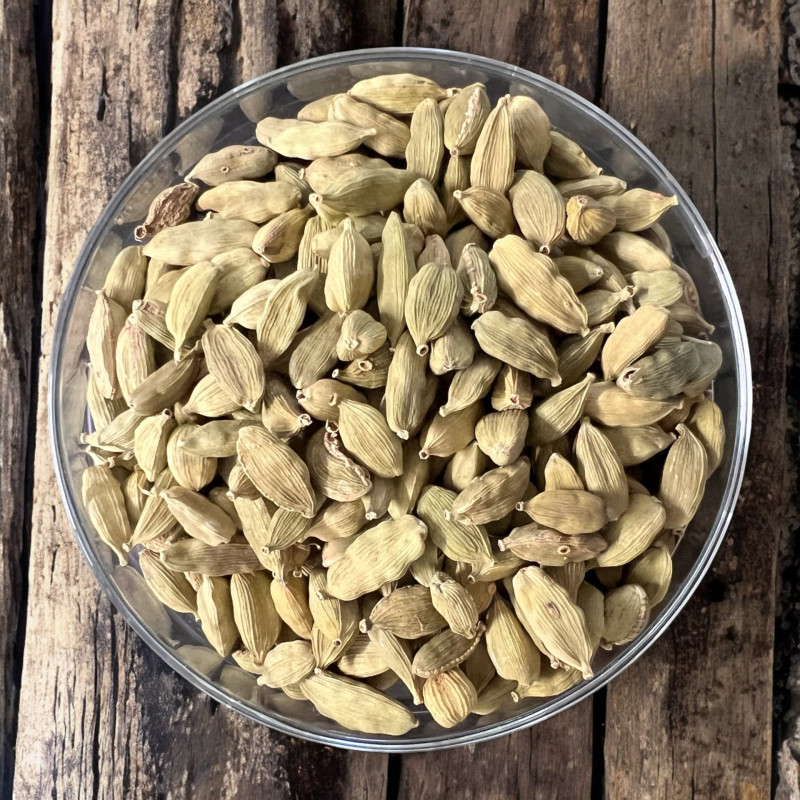
Reference: cardamomeM


Its fragrance is extraordinary and powerful, protected by the green pod of the fruit!
Green cardamom is delicious in tea, coffee, gingerbread, Indian curries, rice, alcoholic beverages, and many dishes. It has the unique ability to enhance the flavors of the dishes it complements.
 Delivery
Delivery
Mondial Relay
 Returns
Returns
See conditions
 Payments
Payments
100% secure
Produit livré en sachet refermable
Uses in Cooking:
Green cardamom pods vary in size, generally between 1 and 2 cm.
Equally at home in both sweet and savory dishes, this spice’s extraordinary and powerful fragrance, reminiscent of eucalyptus but more lemony, is used for its remarkable ability to enhance and beautifully complement a wide variety of dishes and meals.
Cardamom is widely used in Indian cuisine (tea, coffee, rice, curries), as well as in Asian and African cuisine (notably Ethiopian). In Turkey, it is customary to place one seed in each cup of coffee.
In Europe, it’s used in gingerbread (ground in this case), and in Scandinavian countries, it flavors aquavit and bread.
In India, it’s common to chew a few seeds after meals, aiding digestion and leaving the breath fresh for hours (it particularly neutralizes garlic odors).
Cardamom is one of the few spices that can be thrown whole into rice cooking water, infusing the grains deeply. In fact, even in small amounts, it pairs well with many dishes: jams, ice creams, meat sauces, meat terrines, and white pudding.
Who am I?
Origin: Guatemala
Scientific name: Elettaria cardamomum
Cardamom is a rhizome-bearing herbaceous plant belonging to the Zingiberaceae family (like ginger and turmeric), native to the Malabar Coast, which also produces pepper. Domesticated in southern India, it thrives in warm, humid climates.
Cardamom is an expensive spice due to the difficulty and length of its harvest; the flowers and seeds develop at ground level. The dried fruit, used as the spice, appears as almond-green capsules about 1 cm long, containing three compartments filled with dark brown seeds, which hold most of the aroma. When dried, the fruit turns straw-colored. It is also sold as bleached capsules, often artificially treated with chlorine—a less appealing option!
Even the plant's leaves carry the characteristic scent when crushed!
A Little History:
Its name is likely of Indian origin, passed down through the Arabs.
Cardamom made its way to Europe in the Middle Ages, where it was used in the preparation of hypocras, a spiced wine served as an aperitif.
Data sheet
Specific References
Reference: cardamomeM
Reference: 10M6821604
Reference: hypocras
Reference: 108017302
Reference: 6470
Reference: 26545D
Reference: 3N7137901
Reference: EPI230204
Reference: bergamote
Reference: ecorcecitronH
Reference: 10M6821604
Reference: 050721
Reference: 3913
Reference: camomilleRom
Reference: 1N7004306
Reference: baiepassion
Reference: SPW06600
Reference: 7N7525705

Its fragrance is extraordinary and powerful, protected by the green pod of the fruit!
Green cardamom is delicious in tea, coffee, gingerbread, Indian curries, rice, alcoholic beverages, and many dishes. It has the unique ability to enhance the flavors of the dishes it complements.